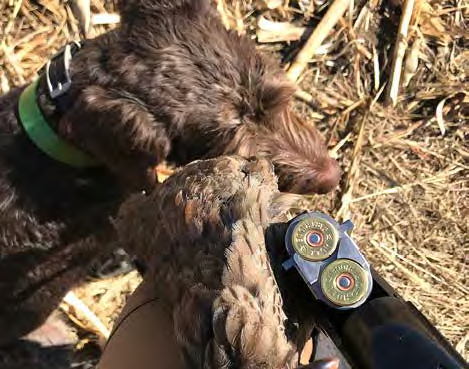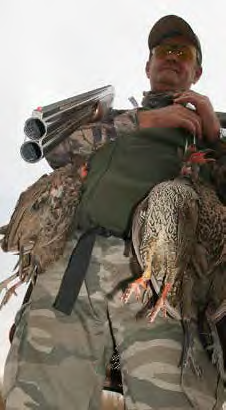Our hunters should obviously dress for the weather, the terrain and the prey. Therefore khakis,
camouflage, etc. are the norms. I wear khakis when hunting terrestrial gamebirds, but when I am after duck and geese then I go unashamedly into full camo gear. I am not ever going to be seen in camos at a clay target range – from what or who would I be hiding?
On one point I am unshakeable, Blaze Orange gear has no place whatsoever where I shoot. Birds have better colour vision than humans and will spot you from way off. To me it merely advertises the fact that you obviously do not trust the folk you shoot with – time for a change perhaps?
If you are on your own, it doesn’t much matter to anyone else what you do, or how you dress and behave. But once you are part of a group, it does. The point is that the actions of any one member of a particular group will always affect that whole group.
How many of us, I wonder, have had shoots spoiled by some jerk arriving in contrasting colours which stick out like a sore thumb? Blue and/or white overalls come to mind…
Competitive shooting has no place in wingshooting, especially with respect to bags. The so-called community shoots so prolific north of Joburg are apparently turning into hotbeds of bad behaviour and the fact that prizes are awarded for the largest bag is deeply and idiotically inane and illegal in most cases. Even prizes for the longest comb on a Guinea-fowl or spurs on a Francolin are unethical, any prizes for killing things are unacceptable. The organisers should
tighten up all round, especially with respect to drinking during the hunt.
One should also consider if the gun fits the occasion. I believe that handguns and shotguns do not mix, and I have picked up handgun cases at pigeon shoots, which worries me. But sadly, in this country it is necessary to be ready for trouble at any time. I know of a friend was pigeon shooting with his son on the East Rand and were approached by three men. Thinking they were going to ask if they could pick up the birds, they were allowed to get too close. They produced pistols, shot his son and beat him up. Leave your handgun in your car while bird shooting, have
it stolen and you are nostril deep in the smelly stuff. So, I now do carry a handgun, but it is kept out of sight.
However, to bring your young son on a bird shoot, armed with a .22 rifle is not only unacceptable, but highly dangerous.
A bird shoot is neither the time nor the place to teach a youngster how to shoot a rifle. If you want to fulfil your paternal duty and teach your son good gun manners and safe practices – go to the local range.
There are many maize and sunflower farms that the owners open up to all and sundry to shoot pigeon and doves in an effort to cut their crop losses. Some of the people who appear on these shoots have to be seen to be believed! Rambos hanging out of bakkies with a beer in one hand and a gun in the other. If that’s how I, as a gun owner and user view them; just imagine how the general public sees them!
Many farmers only do this once or twice because of the mayhem these so-called “hunters” cause. It is not acceptable to leave non-biodegradable empty cartridges, beer cans, boxes and rubbish littered the length and breadth of a sunflower field or veld. It is equally unacceptable to sit between flights plucking dead birds and dumping the feathers, another common occurrence. They may be a more biodegradable form of litter but they still make a mess of someone else’s property. Take a couple of rubbish bags along with you, how hard is that?
We should all be aware of the damage ingested cartridge cases can cause to livestock, which is why it is so important to pick them all up. It is just not possible to pick up the wads, yet these are just as indigestible.
Using a pump or semi-auto shotgun in a group of hunters is also unacceptable, unless everyone is so equipped, or are prepared to take a chance on your gun manners. In other words, they should be asked first. I know that the Americans use them all the time; our norms are significantly different. Our number of bird hunters shot by accident are also significantly (and proportionately) less.
A broken-open empty double is clearly, visibly, safe and the barrels can be continually checked for obstructions.
Many users of double barrel shotguns are very scary as well. All too many casual idiots lean loaded doubles against cars and trees and get badly frightened, or shot, when one gets knocked over. If you are not actually using your gun – unload it and bag it!
Un-bagged guns in vehicles are an absolute no-no. Loaded and un-bagged guns in moving vehicles are an accident waiting to happen.
As for the so-called hunters who charge up and down the edges of sunflower fields in bakkies, shooting on the move at rock pigeons or guinea-fowl, well words fail me!
Any wingshooting from a vehicle, either moving or stationary, is deeply distasteful and in my book, totally unethical.
Many European countries have little to no history of ethics in this field. The moment the hunting season opens in their home countries it is common cause that they go out and shoot at everything with feathers, whether in the air, on the ground or on the water. That is, of course, when they are not shooting at each other and the local cow. How we are going to get them to change boggles the mind. Yet I know many who are total gentlemen in the field, so perhaps all is not lost.
Before I’m accused of racism and xenophobia, let me say that many South African hunters are pretty suspect as well. There is a strong “killer” brigade who only stop shooting when all their cartridges are finished, regardless of bag-limits.
Many take little or no care about what or how they shoot either. If you cannot tell the difference between a raptor and a rock pigeon or a duck and a jacana then you really do not belong in the field.
Our rambos, killers and litterers of the bird hunting field should reflect upon the harm they are doing our cultural activity. They will be the first to whine when there is no longer any free shooting to be had – or any shooting at all for that matter.
Safety and safeties are not to be taken lightly. It can be considered unethical to rely upon a safety catch, unless it is proven to be safe, and how is this to be proved? The hard way? It is a fact that 90% of doublebarrelled shotguns have safeties which only immobilise the trigger/s, not the strikers/hammers inside. Drop a loaded shotgun and it is very likely to go off. The only really safe gun is one that is clearly and obviously empty of cartridges.
Another facet more observed in the breach is bag limits. And when you examine the various provinces laws, it is soon apparent that the law in this case is an ass. How can a bird be considered vermin or near-vermin with an open limit and a year-round season in one province, and in the next-door province it has a small bag limit and couple of months’ seasons. But the law is the law and ethically must be obeyed until we take steps to rectify the inconsistencies.
A really ethical hunter will always count wounded game as part of the bag. Game ranches charge for any wounded game as a matter of course. Why then should we ignore wounded birds? Yet I know that very few bird hunters count them into their bag. In my experience all too many wingshooters shrug off wounded birds far too easily. Given the incredible ability of our gamebirds to conceal themselves, especially when wounded, it could be successfully argued that it is unethical to go hunting birds without a trained dog.
To be ethical, if you knock a bird down out of the sky and cannot find it you must include it in your bag. Its chances of ever flying again are minimal at best.
It is also definitely unethical to shoot ducks and geese over water without a retriever. If you are going to shoot birds, knowing that little or no attempt will be made to fetch them, then please pack up your shotgun and go away. My activity really cannot afford to have you around.
Is it really necessary to stress that alcohol and guns do not go together? I guess so, as all too often one sees people who should know better tucking into beers or hardtack out in the field. Here there is no line to be drawn. It is just not ethical nor legal to drink alcohol and shoot in South Africa.
From time to time, we should all indulge in some quiet reflection. Take stock of what we are doing and if necessary, modify our behaviour. Learn from your mistakes, and if you as an experienced and ethical bird hunter, invite a newcomer to the sport, please take the time to explain what is expected of him. If you are invited on a shoot and are not told what’s what, confess your ignorance and ask your host… That way you might be asked again.
We must acknowledge that there is now little to no control over our sport, the authorities promulgate laws but lack either the incentive or the means to enforce the same, thus we must
become the enforcer, else chaos reigns. Ask yourself – are you totally ethical in your bird hunting?
The ethical wingshooter:
- Obeys all laws pertaining to gamebird hunting.
- Does not drink and shoot.
- Is at all times constantly aware of the need for safety.
- Never loads a weapon until it is about to be used.
- Never puts his finger onto the trigger until he is about to pull it.
- Never relies solely upon a safety catch for a gun’s safety.
- Unloads and bags all firearms when they are not in use.
- Never shoots from a vehicle, either stationary or in motion.
- Desists from taking long (and probably wounding) shots.
- Uses trained dogs in the field.
- Makes every possible effort to retrieve wounded game.
- Includes any wounded or un-retrieved birds in the bag.
- Goes out of his way to help young wing-shooters.
- Is at all times courteous and considerate of companions and other hunters.
- Always ascertains from the landowner what can, and can’t, be shot.
- Never poaches someone else’s shoot.
- Always puts something back into the sport.
- Leaves only footprints.




